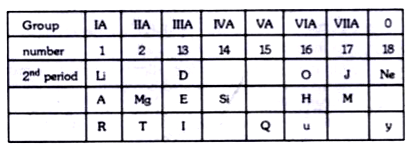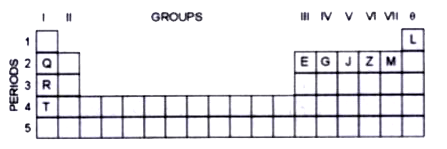Use the periodic table to answer the following questions :
Identify an element with five electrons in the outer subshell.
To identify an element with five electrons in the outer subshell, we can follow these steps:
Step 1: Understand the Electron Configuration
The outer subshell refers to the highest energy level of electrons in an atom. The electrons in the outermost shell determine the chemical properties of the element.
Step 2: Identify the Subshells
The subshells are categorized as s, p, d, and f. The s subshell can hold a maximum of 2 electrons, while the p subshell can hold a maximum of 6 electrons. Therefore, if an element has 5 electrons in its outer subshell, it must be in the p subshell.
Step 3: Locate Elements with 5 Electrons in the p Subshell
Elements that have 5 electrons in the p subshell belong to Group 15 of the periodic table. The elements in this group include nitrogen (N), phosphorus (P), arsenic (As), antimony (Sb), and bismuth (Bi).
Step 4: Check the Electron Configuration
To confirm, we can check the electron configurations of these elements:
- Nitrogen (N): 1s² 2s² 2p³ (5 electrons in the outer shell)
- Phosphorus (P): 1s² 2s² 2p⁶ 3s² 3p³ (5 electrons in the outer shell)
- Arsenic (As): 1s² 2s² 2p⁶ 3s² 3p⁶ 4s² 4p³ (5 electrons in the outer shell)
- Antimony (Sb): 1s² 2s² 2p⁶ 3s² 3p⁶ 4s² 4p⁶ 5s² 5p³ (5 electrons in the outer shell)
- Bismuth (Bi): 1s² 2s² 2p⁶ 3s² 3p⁶ 4s² 4p⁶ 5s² 5p⁶ 6s² 6p³ (5 electrons in the outer shell)
Step 5: Conclusion
Among these elements, nitrogen (N) is the simplest example of an element with 5 electrons in its outer subshell.
Final Answer
The element with five electrons in the outer subshell is Nitrogen (N).
---
The outer subshell refers to the highest energy level of electrons in an atom. The electrons in the outermost shell determine the chemical properties of the element.
The subshells are categorized as s, p, d, and f. The s subshell can hold a maximum of 2 electrons, while the p subshell can hold a maximum of 6 electrons. Therefore, if an element has 5 electrons in its outer subshell, it must be in the p subshell.
Elements that have 5 electrons in the p subshell belong to Group 15 of the periodic table. The elements in this group include nitrogen (N), phosphorus (P), arsenic (As), antimony (Sb), and bismuth (Bi).
To confirm, we can check the electron configurations of these elements:
- Nitrogen (N): 1s² 2s² 2p³ (5 electrons in the outer shell)
- Phosphorus (P): 1s² 2s² 2p⁶ 3s² 3p³ (5 electrons in the outer shell)
- Arsenic (As): 1s² 2s² 2p⁶ 3s² 3p⁶ 4s² 4p³ (5 electrons in the outer shell)
- Antimony (Sb): 1s² 2s² 2p⁶ 3s² 3p⁶ 4s² 4p⁶ 5s² 5p³ (5 electrons in the outer shell)
- Bismuth (Bi): 1s² 2s² 2p⁶ 3s² 3p⁶ 4s² 4p⁶ 5s² 5p⁶ 6s² 6p³ (5 electrons in the outer shell)
Among these elements, nitrogen (N) is the simplest example of an element with 5 electrons in its outer subshell.
The element with five electrons in the outer subshell is Nitrogen (N).
Topper's Solved these Questions
- BOOK - ICSECHAPTER - CLASSIFICATION OF ELEMENTS AND PERIODICITY IN PROPERTIESEXERCISE - ASSERTION-REASON TPE QUESTIONS6videos
CLASSIFICATION OF ELEMENTS AND PERIODICITY IN PROPERTIES
- BOOK - ICSECHAPTER - CHEMICAL THERMODYNAMICS EXERCISE - NCERT TEXT-BOOK. EXERCISES22videos
CHEMICAL THERMODYNAMICS
- BOOK - ICSECHAPTER - ENVIRONMENTAL CHEMISTRY EXERCISE - NCERT TEXT-BOOK EXERCISE20videos
ENVIRONMENTAL CHEMISTRY
Similar Questions
Use the periodic table to answer the following questions.
a. Identify an element with five electrons in the outer subshell.
b. Identify an element that would tend to lose two electrons.
c. Identify an element that would tend to gain two electrons.
d. Identify the group having metal, non-metal, liquid as well as gas at the room temperature.View SolutionUse of Modern periodic table to answer the following questions:
(i) Identify an element with six electrons in the outermost shell.
(ii) Identify an element that would tend to lose one electron.
(ii) Identify an element that would tend to gain three electrons.
(iv) Identify the group having metal, non-metal, liquid as well as gas at 30∘C temperature.View Solution
Knowledge Check
- Question 1 - Select One
Observe the Periodic Table to answer the questions :

In the above table some elements are mentioned with their own symbol and position of the Periodic Table while others are shown with a letter. Answer the following questions pertaining to the same.
Identify the most electronegative elementALiBNeCZDJ - Question 2 - Select One
Observe the Periodic Table to answer the questions :

In the above table some elements are mentioned with their own symbol and position of the Periodic Table while others are shown with a letter. Answer the following questions pertaining to the same.
How many Valence electrons are present in Q?A3B5C15D4
Use the periodic table to answer the following questions :
Identify an element that would tend to gain two electrons.View SolutionUse the periodic table to answer the following questions :
Identify an element that would tend to lose two electrons.View SolutionUse the periodic table to answer the following questions :
Identify the groups having metal, non-metal, liquid as well as gas at the room temperature.View SolutionUse the letters only written in the Periodic Table below to answer the question : Which element has its electrons arranged in four shells.
 View Solution
View Solution
• In this table H does not represent hydrogen.
• Some elements are given in their own symbol and position in the periodic table.
• While others are shown with a letter.
With reference to the table answer the following questions :
Identify the element from period 3 with least atomic size.View SolutionUse the letters only written in the Periodic Table given below to answer the questions that follow :

Which element has its electrons arranged in four shells ?View Solution

